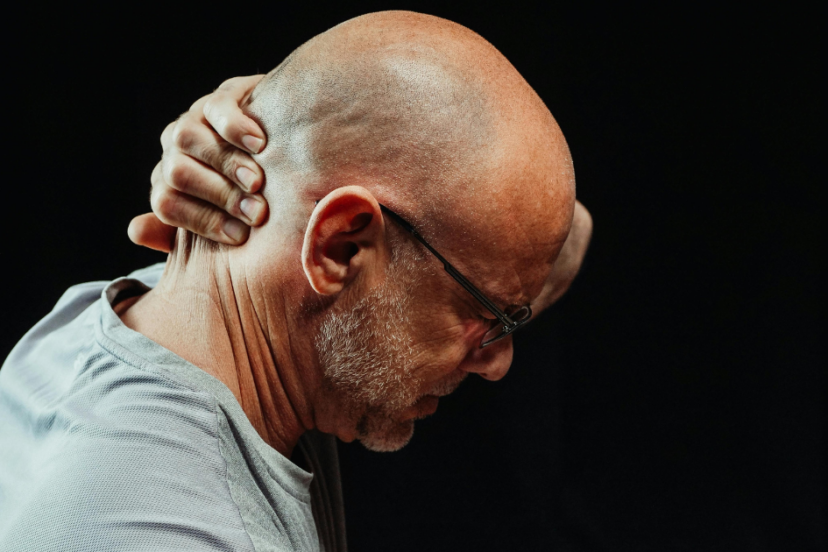Relieve Neck Pain at Base of Skull: 5 Tips and Solutions
Introduction
Dealing with neck pain at the base of the skull can be a frustrating experience. I’ve had my fair share of sleepless nights and uncomfortable days due to this nagging pain. It’s a common issue that affects many people, and if left unaddressed, it can significantly impact your quality of life. In this article, we’ll dive into the various causes, symptoms, and effective treatments for neck pain at the base of the skull. I’ll also share some personal tips and professional recommendations to help you find relief and prevent future discomfort.
What Causes Neck Pain at the Base of the Skull?
Understanding the root cause of your neck pain is crucial for effective treatment. Here are some of the most common causes:
Tension Headaches
Tension headaches are a primary culprit of neck pain. They often result from stress, anxiety, or poor posture. These headaches create a band-like tightness around the head, often radiating down to the neck and base of the skull.
1: Practice stress management techniques such as meditation or deep breathing exercises to reduce tension.
2: Ensure you maintain good posture throughout the day, especially when sitting for long periods.
3: Take regular breaks to stretch and move around if you’re working at a desk.
4: Stay hydrated, as dehydration can exacerbate headache symptoms.
5: Avoid excessive caffeine and alcohol, which can trigger tension headaches.
Poor Posture
Poor posture, particularly when sitting or using electronic devices, can strain the muscles and ligaments in your neck. This strain can lead to chronic pain at the base of the skull.
1: Use ergonomic furniture and adjust your workspace to promote good posture.
2: Keep your computer screen at eye level to avoid looking down for extended periods.
3: Use a supportive chair with proper lumbar support.
4: Avoid cradling your phone between your ear and shoulder.
5: Strengthen your core muscles to support your spine and improve posture.
Muscle Strain
Muscle strain from overuse or sudden movements can cause significant discomfort. This type of strain is common in athletes and individuals who perform repetitive tasks.
1: Warm up properly before engaging in physical activities.
2: Incorporate stretching exercises into your routine to maintain flexibility.
3: Avoid sudden, jerky movements that can strain your neck muscles.
4: Use proper lifting techniques to prevent muscle strain.
5: Consider incorporating yoga or Pilates to improve muscle strength and flexibility.
Cervical Spondylosis
Cervical spondylosis, also known as neck arthritis, involves the degeneration of the cervical spine. This condition can cause pain and stiffness at the base of the skull.
1: Engage in regular low-impact exercise to maintain joint mobility.
2: Use supportive pillows to keep your neck aligned while sleeping.
3: Apply heat or cold therapy to alleviate pain and reduce inflammation.
4: Stay hydrated to maintain the health of your spinal discs.
5: Consult with a healthcare professional for tailored treatment options.
Additional Causes
Other causes of neck pain at the base of the skull can include injuries, infections, and medical conditions such as fibromyalgia.
1: Seek prompt medical attention if you suspect an injury or infection.
2: Keep a pain diary to track symptoms and potential triggers.
3: Follow a healthy diet to support overall wellness and reduce inflammation.
4: Stay active but avoid activities that exacerbate your pain.
5: Work closely with your healthcare provider to identify and manage underlying conditions.
Symptoms of Neck Pain at the Base of the Skull
Recognizing the symptoms associated with neck pain at the base of the skull can help you identify the underlying cause and seek appropriate treatment.
Headaches
Headaches are a common symptom and can vary in intensity from mild to severe. They often start at the base of the skull and may radiate to other parts of the head.
1: Track your headache patterns to identify triggers and patterns.
2: Practice relaxation techniques to reduce the frequency and severity of headaches.
3: Ensure you get enough sleep and maintain a consistent sleep schedule.
4: Avoid excessive screen time and take regular breaks from electronic devices.
5: Consider using essential oils such as lavender or peppermint for headache relief.
Stiff Neck
A stiff neck can make it difficult to move your head and perform daily activities. This stiffness is often accompanied by pain and discomfort.
1: Perform gentle neck stretches to improve flexibility and reduce stiffness.
2: Use a warm compress to relax tense muscles and increase blood flow.
3: Avoid sleeping on your stomach, as this can strain your neck muscles.
4: Maintain good posture throughout the day to prevent stiffness.
5: Consider using a neck brace or collar for short-term relief during acute flare-ups.
Shoulder Pain
Neck pain can radiate to the shoulders, causing additional discomfort and limited mobility.
1: Engage in shoulder-strengthening exercises to support the neck muscles.
2: Apply ice or heat to the affected area to reduce pain and inflammation.
3: Avoid carrying heavy bags on one shoulder, as this can worsen pain.
4: Practice good posture to prevent shoulder strain.
5: Consider physical therapy to address shoulder pain and improve mobility.
Limited Range of Motion
Limited range of motion in the neck can make everyday tasks challenging and uncomfortable.
1: Perform range-of-motion exercises to maintain flexibility and improve movement.
2: Use a foam roller to release tension in the neck and upper back muscles.
3: Avoid sudden, jerky movements that can strain your neck.
4: Incorporate gentle yoga or Pilates into your routine to enhance flexibility.
5: Consult with a healthcare professional for personalized exercise recommendations.
Other Symptoms
Other symptoms of neck pain at the base of the skull can include dizziness, nausea, and tingling or numbness in the arms.
1: Monitor your symptoms closely and seek medical attention if they worsen.
2: Stay hydrated and maintain a healthy diet to support overall wellness.
3: Practice stress management techniques to reduce symptoms.
4: Avoid activities that exacerbate your symptoms and focus on gentle movements.
5: Work with a healthcare professional to identify and manage underlying conditions contributing to your symptoms.
Diagnosis of Neck Pain at the Base of the Skull
Proper diagnosis is essential to determine the most effective treatment for neck pain at the base of the skull. Here are the steps involved in diagnosing this condition:
Medical History Review
Your doctor will start by reviewing your medical history to understand any underlying conditions, previous injuries, or lifestyle factors that may be contributing to your neck pain.
1: Be honest and thorough when discussing your medical history with your doctor.
2: Keep a detailed record of your symptoms, including their frequency, duration, and intensity.
3: Note any triggers or activities that worsen your pain.
4: Mention any medications or supplements you are currently taking.
5: Discuss any family history of neck pain or related conditions.
Physical Examination
A physical examination will help your doctor assess your neck’s range of motion, muscle strength, and areas of tenderness.
1: Wear comfortable clothing to your appointment to allow for a thorough examination.
2: Follow your doctor’s instructions during the physical assessment.
3: Report any pain or discomfort you experience during the examination.
4: Ask questions to understand what your doctor is looking for and why.
5: Take notes on any recommendations or observations made by your doctor.
Imaging Tests
Imaging tests such as X-rays, MRI, or CT scans may be necessary to get a detailed view of your cervical spine and identify any structural issues.
1: Understand the purpose of each imaging test and how it will help in your diagnosis.
2: Follow pre-test instructions, such as fasting or avoiding certain medications, if required.
3: Ask about the risks and benefits of each imaging test.
4: Ensure you follow up with your doctor to discuss the results of your imaging tests.
5: Keep copies of your imaging results for your records and future reference.
Differential Diagnosis
A differential diagnosis involves ruling out other conditions that may cause similar symptoms, such as migraines or nerve compression.
1: Be open to multiple diagnostic approaches to accurately identify the cause of your pain.
2: Keep track of any new or changing symptoms and report them to your doctor.
3: Understand that the diagnostic process may take time and require multiple visits.
4: Ask your doctor to explain the reasoning behind each potential diagnosis.
5: Stay informed about the conditions being considered in your differential diagnosis.
Other Diagnostic Methods
Additional diagnostic methods, such as blood tests or nerve conduction studies, may be used to identify underlying conditions or nerve damage.
1: Follow any pre-test instructions provided by your healthcare provider.
2: Understand the purpose and procedure of each additional test.
3: Ask about the accuracy and reliability of these tests.
4: Stay patient and engaged in the diagnostic process.
5: Work closely with your healthcare team to ensure a comprehensive evaluation.
5 Tips: Home Remedies for Neck Pain Relief
Many people find relief from neck pain through simple home remedies. Here are some effective methods you can try:
1. Heat and Cold Therapy
Applying heat or cold to the affected area can help reduce pain and inflammation.
1: Use a heating pad or warm towel for 15-20 minutes at a time to relax tense muscles.
2: Apply an ice pack wrapped in a cloth for 10-15 minutes to reduce swelling and numb pain.
3: Alternate between heat and cold therapy to maximize relief.
4: Avoid applying heat or cold directly to the skin to prevent burns or frostbite.
5: Incorporate these therapies into your daily routine, especially after activities that strain your neck.
2. Stretching Exercises
Gentle stretching can help improve flexibility and reduce muscle tension.
1: Perform neck stretches daily, focusing on all directions (forward, backward, side-to-side).
2: Hold each stretch for at least 30 seconds and repeat several times.
3: Incorporate upper body stretches to relieve tension in the shoulders and upper back.
4: Avoid bouncing or jerking movements during stretches to prevent injury.
5: Consult with a physical therapist for personalized stretching recommendations.
3. Over-the-Counter Pain Relievers
OTC pain relievers can help manage pain and reduce inflammation.
1: Use nonsteroidal anti-inflammatory drugs (NSAIDs) such as ibuprofen or naproxen for pain relief.
2: Follow the dosage instructions on the label to avoid side effects.
3: Consider using topical pain relievers like creams or gels for targeted relief.
4: Avoid using OTC pain relievers for extended periods without consulting a doctor.
5: Explore natural supplements like turmeric or ginger for their anti-inflammatory properties.
4. Proper Sleeping Positions
Your sleeping position can significantly impact neck pain. Adopting the right position can help alleviate discomfort.
1: Use a supportive pillow that keeps your neck in a neutral position.
2: Avoid sleeping on your stomach, as this can strain your neck muscles.
3: Sleep on your back or side with a pillow that supports the natural curve of your neck.
4: Use a body pillow to maintain proper alignment if you sleep on your side.
5: Experiment with different pillow heights and firmness levels to find what works best for you.
5. Home Massage Techniques
Massaging the neck and upper back can help relieve muscle tension and improve blood flow.
1: Use your fingertips to apply gentle pressure to the base of your skull and along your neck.
2: Incorporate circular motions and kneading techniques to target tense areas.
3: Use massage tools like foam rollers or handheld massagers for deeper relief.
4: Consider using essential oils like lavender or eucalyptus to enhance the massage experience.
5: Schedule regular self-massage sessions, especially after stressful or physically demanding days.
Professional Treatments for Neck Pain

When home remedies aren’t enough, professional treatments can provide significant relief. Here are some effective options:
Physical Therapy
Physical therapy can help strengthen muscles, improve flexibility, and alleviate pain.
1: Work with a licensed physical therapist to develop a personalized treatment plan.
2: Attend all scheduled therapy sessions and follow your therapist’s instructions.
3: Perform prescribed exercises at home to complement your therapy sessions.
4: Track your progress and communicate any concerns with your therapist.
5: Stay committed to your therapy plan, even if progress seems slow.
Chiropractic Care
Chiropractic adjustments can help realign the spine and relieve neck pain.
1: Choose a licensed chiropractor with experience in treating neck pain.
2: Discuss your symptoms and medical history with your chiropractor before starting treatment.
3: Follow your chiropractor’s recommendations for at-home care and exercises.
4: Monitor your response to chiropractic adjustments and report any adverse effects.
5: Consider regular chiropractic visits to maintain spinal health and prevent future pain.
Massage Therapy
Professional massage therapy can target deep muscle tension and promote relaxation.
1: Schedule regular appointments with a licensed massage therapist.
2: Communicate your pain points and preferences with your therapist.
3: Incorporate different types of massage, such as deep tissue or Swedish, to address various needs.
4: Hydrate well before and after your massage to aid in muscle recovery.
5: Combine massage therapy with other treatments for comprehensive pain management.
Medications
Prescription medications can help manage severe or chronic neck pain.
1: Consult with your doctor to determine if prescription medications are appropriate for your condition.
2: Follow the prescribed dosage and instructions carefully.
3: Be aware of potential side effects and report any adverse reactions to your doctor.
4: Use medications in conjunction with other treatments, such as physical therapy or chiropractic care.
5: Regularly review your medication plan with your doctor to adjust as needed.
Acupuncture
Acupuncture involves inserting thin needles into specific points on the body to relieve pain and promote healing.
1: Seek treatment from a licensed and experienced acupuncturist.
2: Discuss your symptoms and medical history with your acupuncturist before starting treatment.
3: Attend multiple sessions, as acupuncture often requires several treatments to be effective.
4: Follow any aftercare instructions provided by your acupuncturist.
5: Consider combining acupuncture with other complementary therapies for enhanced relief.
Prevention Tips for Avoiding Neck Pain
Preventing neck pain is often easier than treating it. Here are some tips to help you avoid discomfort:
Maintaining Good Posture
Good posture is essential for preventing neck pain.
1: Keep your shoulders back and your head aligned with your spine.
2: Avoid slouching or leaning forward when sitting or standing.
3: Use ergonomic furniture and equipment to support proper posture.
4: Adjust
your workspace to ensure your computer screen is at eye level and your chair provides adequate lumbar support.
5: Take regular breaks to stand, stretch, and move around to avoid prolonged periods in one position.
Ergonomic Workspaces
Creating an ergonomic workspace can help prevent strain and discomfort.
1: Use a chair with adjustable height, backrest, and armrests to support proper posture.
2: Position your keyboard and mouse within easy reach to avoid overextending your arms.
3: Ensure your feet are flat on the floor or on a footrest to maintain a neutral posture.
4: Use a headset or speakerphone for long phone calls to avoid cradling the phone between your shoulder and ear.
5: Arrange your workspace to minimize repetitive movements and awkward positions.
Regular Exercise
Regular exercise helps maintain flexibility, strength, and overall health, reducing the risk of neck pain.
1: Incorporate both cardiovascular and strength training exercises into your routine.
2: Focus on exercises that strengthen the neck, shoulders, and upper back.
3: Include flexibility exercises such as yoga or Pilates to maintain range of motion.
4: Stay active throughout the day by taking short walks or stretching breaks.
5: Consult with a fitness professional to develop a balanced exercise plan.
Stress Management Techniques
Stress can contribute to muscle tension and neck pain. Managing stress is crucial for prevention.
1: Practice relaxation techniques such as deep breathing, meditation, or progressive muscle relaxation.
2: Engage in activities that you enjoy and find relaxing, such as reading, gardening, or listening to music.
3: Exercise regularly to reduce stress and improve overall well-being.
4: Get adequate sleep each night to help your body recover and manage stress more effectively.
5: Consider talking to a counselor or therapist if stress becomes overwhelming.
Healthy Lifestyle Habits
Adopting a healthy lifestyle can help prevent neck pain and improve overall well-being.
1: Maintain a balanced diet rich in fruits, vegetables, lean proteins, and whole grains.
2: Stay hydrated by drinking plenty of water throughout the day.
3: Avoid smoking and limit alcohol consumption, as these can contribute to inflammation and poor health.
4: Get regular medical check-ups to monitor your health and catch any issues early.
5: Prioritize self-care and make time for activities that promote relaxation and well-being.
When to See a Doctor
It’s important to know when to seek professional help for neck pain. Here are some situations where seeing a doctor is necessary:
Persistent Pain
If your neck pain persists for more than a few days or weeks despite home treatment, it’s time to consult a doctor.
1: Keep a pain diary to track your symptoms and their duration.
2: Note any activities or treatments that provide relief or worsen your pain.
3: Be prepared to discuss your pain history in detail with your doctor.
4: Follow your doctor’s recommendations for further testing or treatment.
5: Stay proactive in seeking a diagnosis and exploring treatment options.
Severe Symptoms
Severe symptoms, such as intense pain, sudden weakness, or loss of bladder or bowel control, require immediate medical attention.
1: Seek emergency care if you experience any severe symptoms.
2: Avoid any activities that could exacerbate your symptoms.
3: Inform your doctor about any sudden changes in your condition.
4: Follow all medical instructions carefully to ensure proper treatment and recovery.
5: Stay informed about potential complications and seek prompt care if symptoms worsen.
Underlying Conditions
If you have an underlying condition such as arthritis, osteoporosis, or a herniated disc, consult a doctor for a tailored treatment plan.
1: Keep your doctor informed about your medical history and any existing conditions.
2: Follow your doctor’s recommendations for managing your underlying condition.
3: Monitor your symptoms closely and report any changes to your doctor.
4: Stay proactive in managing your condition with lifestyle changes and treatment.
5: Seek support from healthcare professionals to optimize your care.
Sudden Onset of Symptoms
If you experience a sudden onset of neck pain following an injury or accident, seek immediate medical evaluation.
1: Avoid moving your neck excessively until you receive medical evaluation.
2: Use ice to reduce swelling and inflammation in the immediate aftermath of an injury.
3: Follow all medical advice and instructions for injury care.
4: Report any symptoms such as numbness, tingling, or weakness to your doctor.
5: Consider a follow-up appointment to monitor your recovery and address any lingering issues.
Guidance on Seeking Professional Help
Knowing when and how to seek professional help is crucial for managing neck pain effectively.
1: Schedule regular check-ups with your primary care physician.
2: Keep an open line of communication with your healthcare providers.
3: Seek second opinions if necessary to explore all treatment options.
4: Stay informed about your condition and treatment options.
5: Advocate for your health and well-being by actively participating in your care.
Conclusion
Neck pain at the base of the skull can be debilitating, but with the right knowledge and approach, it’s possible to manage and even prevent this discomfort. By understanding the causes, recognizing the symptoms, and exploring various treatment options, you can find the relief you need. Remember to prioritize good posture, maintain a healthy lifestyle, and seek professional help when necessary. With these strategies, you can take control of your neck pain and improve your overall quality of life.
FAQs
1. What are the common causes of neck pain at the base of the skull?
Common causes include tension headaches, poor posture, muscle strain, cervical spondylosis, and injuries.
2. How can I relieve neck pain at home?
Home remedies include heat and cold therapy, stretching exercises, over-the-counter pain relievers, proper sleeping positions, and home massage techniques.
3. When should I see a doctor for neck pain?
Consult a doctor if your pain persists for more than a few days, is severe, follows an injury, or is accompanied by symptoms like numbness or weakness.
4. Can poor posture really cause neck pain?
Yes, poor posture can strain the muscles and ligaments in your neck, leading to pain and discomfort.
5. Are there long-term treatments for chronic neck pain?
Long-term treatments include physical therapy, chiropractic care, massage therapy, medications, and lifestyle changes to manage and prevent pain.

*We may earn a commission from purchases made through our links, at no cost to you. This does not affect our product recommendations. Please see our disclosure to learn more.
![Urban Health Hive]](https://urbanhealthhive.com/wp-content/uploads/2023/05/cropped-cropped-Health_Logo.png)



